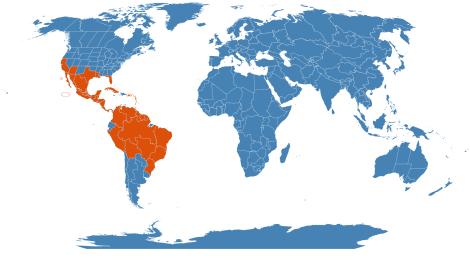Accession Data
Vachellia farnesiana
Common Name: Sweet Acacia, Popinac, Sponge Tree
Family: Fabaceae
Synonym(s): Acacia farnesiana (L.) Willd.
Country of Origin: widely naturalized, but probably native to S. USA and Mexico
Description: Thorny bush or small tree, 8 m tall; bark light brown, rough; branches glabrous or nearly, purplish to gray, with very small glands; stipules spinescent, usually short, up to 1.8 cm long, rarely longer, never inflated; leaves twice pinnate, with a small gland on petiole and sometimes one on the rachis near top of pinnae; pinnae 2–8 pairs, leaflets 10–12 pairs, minute, 2–7 mm long, 0.75–1.75 mm wide, glabrous, leathery; flowers in axillary pedunculate heads, calyx and corolla glabrous, scented; pod indehiscent, straight or curved, 4–7.5 cm long, about 1.5 cm wide, subterete and turgid, dark brown to blackish, glabrous, finely longitudinally striate, pointed at both ends; seeds chestnut-brown, in 2 rows, embedded in a dry spongy tissue, 7–8 mm long, ca 5.5 mm broad, smooth, elliptic, thick, only slightly compressed; areole 6.5–7 mm long, 4 mm wide.
Cassie perfume is distilled from the flowers. Cassie absolute is employed in preparation of violet bouquets, extensively used in European perfumery. Cassie pomades are manufactured In Uttar Pradesh and the Punjab. Pods contain 23 percent tannin, a glucoside of ellagic acid, and are used for tanning leather. Bark also used for tanning and dying leather in combination with iron ores and salts. In Bengal and West Indies, pods are used for a black leather dye. Gummy substance obtained from pods used in Java as cement for broken crockery. Gum exuding from trunk considered superior to gum arabic in arts. Trees used as ingredient in Ivory Coast for arrow poison; elsewhere they are used as fences and to check erosion. Wood is hard and durable underground, used for wooden plows and for pegs. Trees often planted as an ornamental. Morton (1981) says that the seeds, containing an unnamed alkaloid, are used to kill rabid dogs in Brazil.
Probably native to sub-tropical America, but naturalized and cultivated all over the world, e.g. Africa (Rhodesia, Mozambique) and Australia. Planted in coastal areas of Ghana and elsewhere in tropical Africa. Grown throughout India, and often planted in gardens.
Thrives in dry localities and on loamy or sandy soils where it may serve as a sand binder. Will grow on loose sandy soil of river beds, on pure sand in plains of Punjab. Requires a dry tropical climate. Ranging from Warm Temperate Dry through Tropical Desert to Moist Forest Life Zones, cassie is reported to tolerate annual precipitation of 6.4–40.3 dm (mean of 20 cases 14.0 dm), annual mean temperature of 14.7–27.8°C (mean of 20 cases = 24.1°C), and pH of 5.0–8.0 (mean of 15 cases = 6.8).
Uses: The bark and the fruit are a source of tannin and used in making dyes and inks.
Accession Data
USDA Zone: 9-11
Accession #: 198500174
Accession Date: 1985-12-31 00:00:00
Bloom Status: 🪴 Not Flowering
Location: 1318
Quantity: 2
Source: Unknown
Classification
Division: Magnoliophyta
Class: Magnoliopsida
Subclass: eurosid I
Order: Fabales
Family: Fabaceae
SubFamily: Mimosoideae
Tribe: Acacieae
Flowering Data:
This accession has been observed in bloom on:| Year | Jan | Feb | Mar | Apr | May | Jun | Jul | Aug | Sep | Oct | Nov | Dec | ||||||||||||||||||||||||||||||||||||||||
|---|---|---|---|---|---|---|---|---|---|---|---|---|---|---|---|---|---|---|---|---|---|---|---|---|---|---|---|---|---|---|---|---|---|---|---|---|---|---|---|---|---|---|---|---|---|---|---|---|---|---|---|---|
| 2025 | ||||||||||||||||||||||||||||||||||||||||||||||||||||
| 2024 | ||||||||||||||||||||||||||||||||||||||||||||||||||||
| 2023 | ||||||||||||||||||||||||||||||||||||||||||||||||||||
| 2022 | ||||||||||||||||||||||||||||||||||||||||||||||||||||
| 2021 | ||||||||||||||||||||||||||||||||||||||||||||||||||||
| 2020 | ||||||||||||||||||||||||||||||||||||||||||||||||||||
| 2019 | ||||||||||||||||||||||||||||||||||||||||||||||||||||
| 2018 | ||||||||||||||||||||||||||||||||||||||||||||||||||||
| 2017 | ||||||||||||||||||||||||||||||||||||||||||||||||||||
| 2016 | ||||||||||||||||||||||||||||||||||||||||||||||||||||
| 2015 | ||||||||||||||||||||||||||||||||||||||||||||||||||||
| 2014 | ||||||||||||||||||||||||||||||||||||||||||||||||||||
| 2013 | ||||||||||||||||||||||||||||||||||||||||||||||||||||
| 2012 | ||||||||||||||||||||||||||||||||||||||||||||||||||||
| 2011 | ||||||||||||||||||||||||||||||||||||||||||||||||||||
| 2010 | ||||||||||||||||||||||||||||||||||||||||||||||||||||
| 2009 | ||||||||||||||||||||||||||||||||||||||||||||||||||||
| 2008 | ||||||||||||||||||||||||||||||||||||||||||||||||||||
| 2007 | ||||||||||||||||||||||||||||||||||||||||||||||||||||
| 2006 | ||||||||||||||||||||||||||||||||||||||||||||||||||||
References
- Vachellia farnesiana Factsheet - dead link as of last access on Tuesday, February 13, 2018.
- Acacia farnesiana at Plants For A Future. Last accessed on Tuesday, February 13, 2018.
- Acacia farnesiana at Purdue NewCrops Website. Last accessed on Tuesday, February 13, 2018.
- The Plant List (2013). Version 1.1. Last accessed on Tuesday, February 13, 2018.
- Vachellia farnesiana at ARS-GRIN. Last accessed on Tuesday, February 13, 2018.
Images

